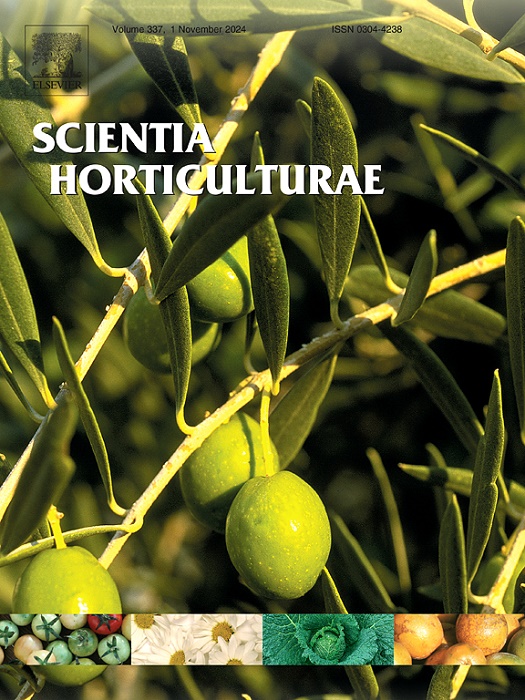全面鉴定紫薇基因组中的 PIN 和 PILS,揭示它们在芽到枝发育和胼胝体生成中的推定功能
IF 3.9
2区 农林科学
Q1 HORTICULTURE
引用次数: 0
摘要
植物中的极性辅素转运是由 PIN-FORMED(PIN)和 PIN-like(PILS)基因分别编码的流入和流出转运体促进的。虽然对各种单子叶植物和双子叶植物的辅素转运体基因家族进行了广泛的研究,但目前还缺乏对籼稻中 PIN 和 PILS 基因家族的全基因组范围的全面分析。本研究在籼稻基因组中发现了 22 个 LiPIN 和 LiPILS 基因,分布在 17 条染色体上。基因结构和保守基序分析表明,同组内的基因相对保守。此外,我们还在 LiPIN 和 LiPILS 基因中发现了 16 对同源基因,其 Ka/Ks 值低于 1,表明在进化过程中存在纯化选择。表达谱分析表明,几个基因,特别是 LiPIN3a 和 LiPILS5b/6a/6b/6c 对盐胁迫有反应。LiPIN1d、LiPIN5和LiPILS3a可能与籼稻芽到分枝的发育有关。此外,LiPILS3a和LiPILS5a的表达水平在胼胝体形成过程中表现出显著差异,表明它们可能是这一发育阶段的关键调控因子。这些发现为我们了解籼稻中的辅素转运体基因提供了新的视角,并加深了我们对它们在抗逆、生长和发育过程中作用的理解。本文章由计算机程序翻译,如有差异,请以英文原文为准。
Comprehensive identification of PIN and PILS in crape myrtle genomes reveals their putative functions in bud-to-branch development and callus generation
Polar auxin transport in plants is facilitated by influx and efflux transporters encoded by PIN-FORMED (PIN) and PIN-like (PILS) genes, respectively. While the auxin transporter gene families have been extensively studied in various monocot and dicot species, a comprehensive genome-wide analysis of PIN and PILS gene families in Lagerstroemia indica is currently lacking. In this study, we identified 22 LiPIN and LiPILS genes in L. indica genome, distributed across 17 chromosomes. Gene structure and conserved motif analyses revealed relative conservation within the same group. Additionally, we identified 16 syntenic gene pairs in LiPIN and LiPILS genes, with Ka/Ks values below 1 indicating purifying selection during evolutionary processes. Expression profiling indicated that several genes, notably LiPIN3a and LiPILS5b/6a/6b/6c, responded to salt stress. LiPIN1d, LiPIN5, and LiPILS3a were potentially linked to bud-to-branch development in L. indica. Moreover, the expression levels of LiPILS3a and LiPILS5a exhibited significant differences during the callus formation process, indicating their potential as key regulatory factors in this developmental stage. These findings offered new insights into auxin transporter genes in L. indica and enhanced our understanding of their roles in stress tolerance, growth, and development.
求助全文
通过发布文献求助,成功后即可免费获取论文全文。
去求助
来源期刊

Scientia Horticulturae
农林科学-园艺
CiteScore
8.60
自引率
4.70%
发文量
796
审稿时长
47 days
期刊介绍:
Scientia Horticulturae is an international journal publishing research related to horticultural crops. Articles in the journal deal with open or protected production of vegetables, fruits, edible fungi and ornamentals under temperate, subtropical and tropical conditions. Papers in related areas (biochemistry, micropropagation, soil science, plant breeding, plant physiology, phytopathology, etc.) are considered, if they contain information of direct significance to horticulture. Papers on the technical aspects of horticulture (engineering, crop processing, storage, transport etc.) are accepted for publication only if they relate directly to the living product. In the case of plantation crops, those yielding a product that may be used fresh (e.g. tropical vegetables, citrus, bananas, and other fruits) will be considered, while those papers describing the processing of the product (e.g. rubber, tobacco, and quinine) will not. The scope of the journal includes all horticultural crops but does not include speciality crops such as, medicinal crops or forestry crops, such as bamboo. Basic molecular studies without any direct application in horticulture will not be considered for this journal.
 求助内容:
求助内容: 应助结果提醒方式:
应助结果提醒方式:


